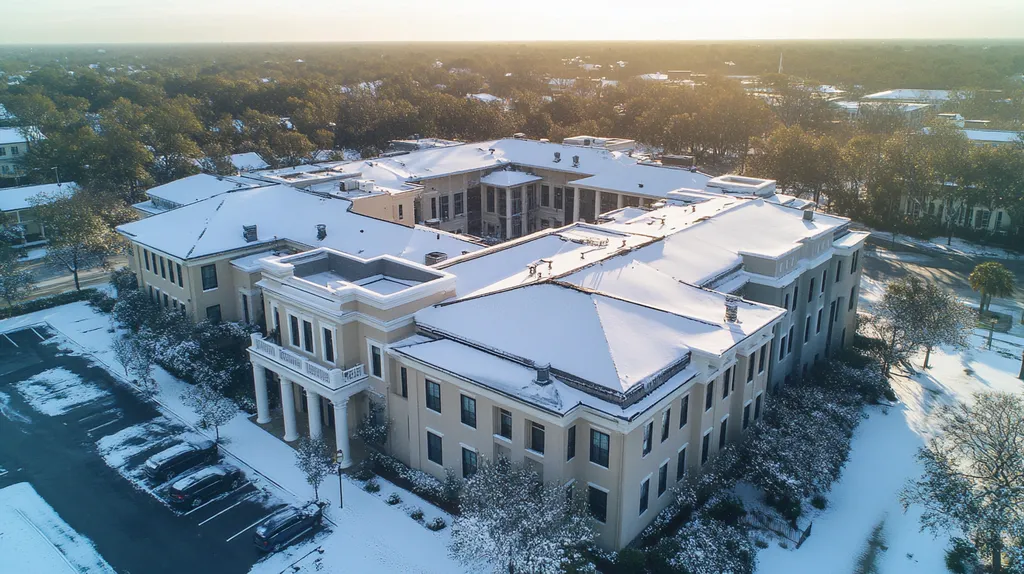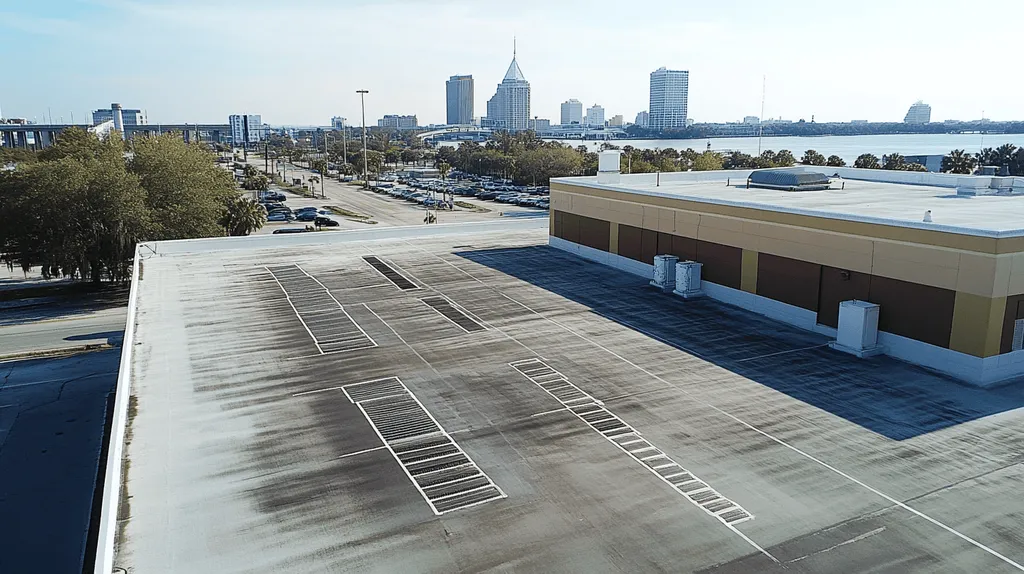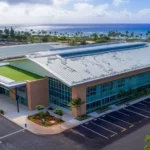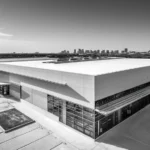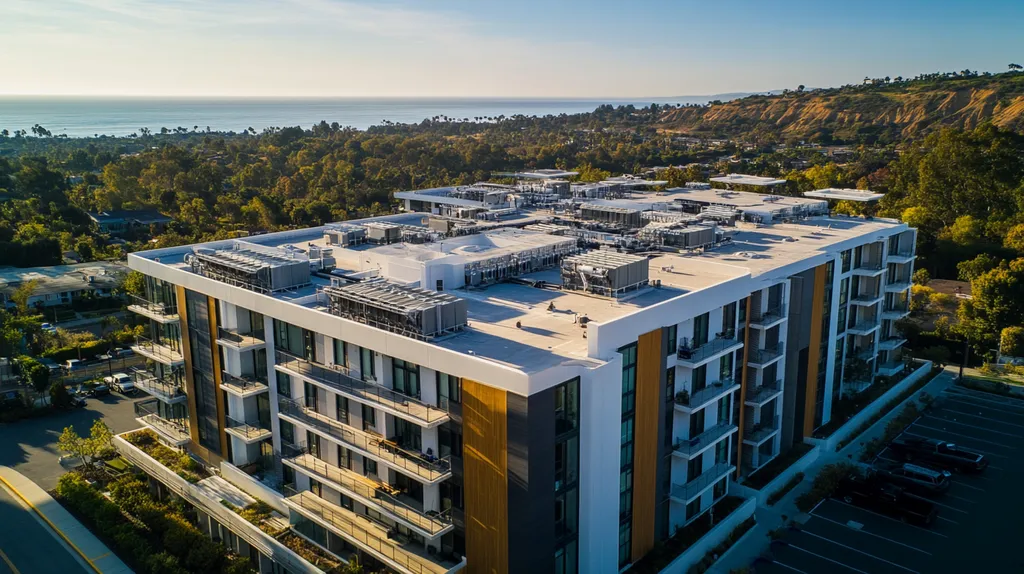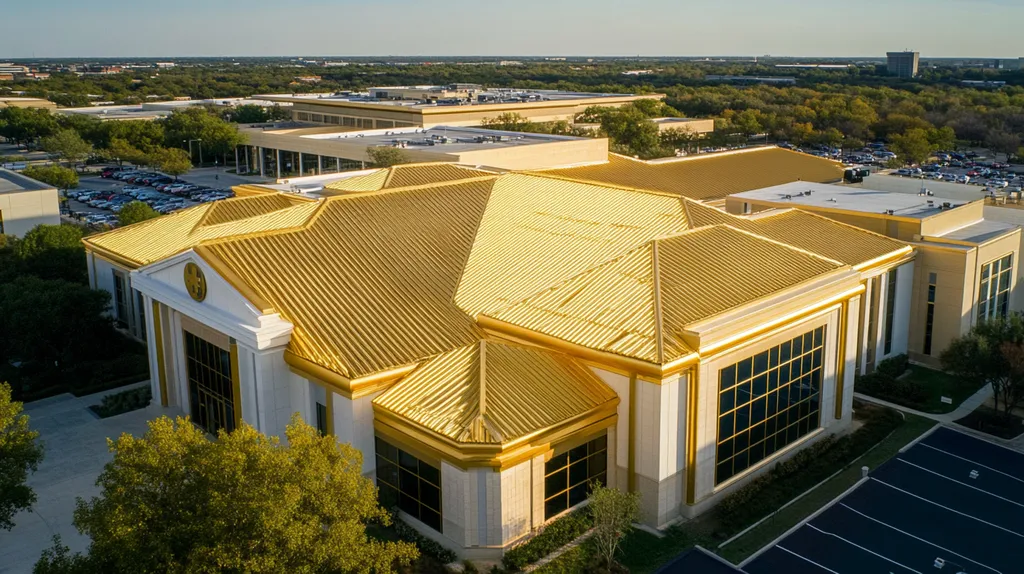While conventional wisdom suggests industrial roofs should last 20-30 years, a shocking 80% are failing at half their intended lifespan. Like watching a million-dollar investment evaporate, facility managers across the country are discovering their traditional maintenance approaches may actually accelerate roof deterioration.
From inadequate drainage systems that turn rooftops into accidental pools, to maintenance protocols that treat all roofs like identical twins, the industry’s established methods are proving about as effective as using an umbrella in a hurricane.
This analysis challenges traditional roofing practices while revealing how data-driven alternatives can double roof longevity without doubling maintenance budgets.
SECTION 1: CURRENT PRACTICES
While your industrial roof silently shields millions in assets, conventional maintenance practices might be its worst enemy. Studies show that 80% of commercial roofs fail prematurely due to inadequate or improper maintenance protocols. Like an expensive suit left out in the rain, these valuable assets often deteriorate faster than necessary because of outdated care routines that miss critical warning signs.
Routine Inspection Frequencies
Most facility managers treat roof inspections like annual flu shots – a predictable but infrequent event. This “set it and forget it” mentality leaves massive gaps where small issues can balloon into budget-busting disasters.
The traditional spring-and-fall inspection schedule ignores the unique stress patterns each roof faces. A warehouse in Minnesota endures different challenges than one in Arizona, yet both often receive identical inspection frequencies.
Modern monitoring reveals that up to 60% of serious roofing issues develop between scheduled inspections. Like watching a movie by only viewing every tenth frame, biannual checks miss crucial plot developments in your roof’s story.
Digital monitoring systems now allow for continuous assessment, but many facilities cling to outdated schedules like a security blanket that’s full of holes.
Standard Maintenance Schedules
The calendar-based maintenance approach treats every roof like it’s reading from the same script. However, factors like local climate, building use, and roofing materials demand customized care routines.
Current maintenance schedules typically focus on surface-level cleaning and basic repairs. This superficial treatment often misses the subtle signs of developing problems, much like treating a fever while ignoring the underlying infection.
Regular inspections should examine seams and joints for wear, maintain proper drainage systems, and ensure thorough cleaning to prevent debris accumulation. (source: Meredith Plays)
Many facilities still rely on reactive maintenance, waiting for visible problems before taking action. This approach is about as effective as starting a diet after your pants split.
Common Repair Practices
Current repair methods often resemble putting a Band-Aid on a broken bone. Quick fixes and patch jobs dominate the industry, creating a false sense of security while underlying issues fester.
The “repair and repeat” cycle has become so normalized that many facility managers budget for it annually. However, this approach typically costs 3-4 times more than comprehensive preventive maintenance over a roof’s lifetime.
Most repairs focus on visible symptoms rather than root causes. When a leak appears, the typical response is to patch the immediate area without investigating why the membrane failed in the first place.
Modern diagnostic tools can pinpoint moisture intrusion and thermal loss patterns, yet many facilities still rely on the “peek and patch” method that’s about as reliable as weather forecasting was in the 1800s.
SECTION 2: SYSTEMIC ISSUES
While your industrial roof quietly shoulders its burden, three silent saboteurs may be conspiring against it. Like a well-orchestrated heist, inadequate drainage, neglected surfaces, and untrained personnel can strip years from your roof’s life expectancy. Industry data shows that these systemic issues account for over 70% of premature roof failures, turning what should be a 20-year asset into a 7-year liability.
Inadequate Drainage Systems
Your roof’s drainage system is like its circulatory system – when it clogs, everything suffers. Standing water weighs about 5 pounds per square foot, turning puddles into concrete-cracking bullies that can compress insulation and stress structural components.
Most drainage systems suffer from the “set it and forget it” syndrome, with maintenance often limited to crisis response. That lovely garden growing in your gutters? It’s actually a tiny ecosystem plotting your roof’s demise.
Even well-designed systems can fail when overwhelmed by debris or irregular maintenance. A single clogged drain during a heavy storm can create a rooftop swimming pool faster than you can say “structural damage.”
Smart facility managers are now treating drainage systems like crucial infrastructure rather than mere afterthoughts. Regular cleaning and inspection of drains, scuppers, and gutters should be as routine as checking your blood pressure.
Neglect of Roof Surface Conditions
Your roof’s surface is like skin – it needs protection and regular check-ups to stay healthy. UV rays, temperature swings, and chemical exposure conspire daily to accelerate aging, yet many facilities treat surface maintenance like optional cosmetic care.
Seams and joints, particularly vulnerable to weathering, often show the first signs of trouble. These industrial roof “wrinkles” can quickly become pathways for moisture infiltration.
Surface deterioration follows a snowball effect – small problems become big ones with frightening speed. A minor blister today could be tomorrow’s major leak, while ignored ponding areas become breeding grounds for membrane-eating microorganisms.
Regular inspections should examine seams and joints for wear, maintain proper drainage systems, and ensure thorough cleaning to prevent debris accumulation. (source: Meredith Plays)
Insufficient Training for Rooftop Workers
Sending untrained personnel onto your roof is like letting a teenager perform brain surgery – the potential for disaster is enormous. Every footstep, tool placement, and maintenance decision can impact roof longevity.
Many facilities treat their roofs like walkways, allowing unrestricted access without proper training. The result? Punctured membranes from dropped tools, compressed insulation from heavy equipment, and maintenance “solutions” that create more problems than they solve.
Even well-intentioned workers can cause damage through ignorance. That satellite dish installation? It might have just created a dozen new leak points. Those new HVAC units? They could be directing corrosive condensation straight onto your membrane.
Training programs should cover not just safety protocols but also roof system awareness. Understanding how different components work together helps prevent accidental damage during routine maintenance or modifications.
SECTION 3: MISSED OPPORTUNITIES
While facility managers chase profit margins with both hands, millions in potential savings slip through their fingers due to overlooked roofing opportunities. Like ignoring a slow leak in your retirement account, these missed chances compound over time, draining resources faster than a broken gutter in a monsoon. Research shows that implementing just three key preventative measures could extend roof life by 40% – yet most facilities continue leaving money on the table like chips in an abandoned poker game.
Overlooking Preventative Coatings
Think of preventative coatings as sunscreen for your roof – skip it and you’ll pay the price sooner rather than later. Yet 70% of facilities treat these protective layers as optional luxuries rather than essential armor against the elements.
Modern coating technologies can reflect up to 85% of solar radiation, dramatically reducing thermal stress on roofing materials. That’s like giving your roof an umbrella, sunglasses, and a cool drink all at once.
The math is simple but brutal: A $50,000 coating investment today can prevent a $500,000 premature replacement tomorrow. Yet many facilities gamble with these odds, treating their roofs like disposable assets.
Without protective coatings, your roof ages like a convertible left outside with the top down – rapidly and expensively. The resulting UV damage, moisture infiltration, and thermal shock can cut years off its serviceable life.
Ignoring Energy Efficiency Improvements
Your roof isn’t just a hat for your building – it’s potentially your biggest energy savings account. Yet most facilities let this account collect dust instead of dividends, ignoring upgrades that could slash cooling costs by up to 30%.
Smart energy improvements work like compound interest for your roof’s lifespan. Reflective surfaces reduce thermal stress, efficient insulation stabilizes interior temperatures, and proper ventilation prevents moisture buildup.
The numbers tell a compelling story: Buildings with energy-efficient roofing systems spend 15-20% less on climate control. That’s like getting a raise just for making better roofing choices.
Even small improvements can yield substantial returns. Something as simple as adding a reflective coating can reduce peak cooling demand by up to 15%, yet many facilities continue cooking their profits away under dark, heat-absorbing surfaces.
Lack of Regular Cleaning Protocols
A dirty roof is like a neglected bank account – it costs you money every day you ignore it. Yet countless facilities treat roof cleaning like an optional luxury rather than a critical maintenance task.
Debris accumulation creates micro-dams that trap moisture against roofing materials, accelerating deterioration faster than a caffeinated countdown. Regular cleaning prevents these moisture traps while allowing early detection of developing issues.
When dirt, leaves, and other debris pile up, they become nature’s sandpaper, gradually wearing away at your roofing investment. These materials also retain moisture, creating perfect conditions for premature aging and biological growth.
Seams and joints, particularly vulnerable to weathering, often show the first signs of trouble. Regular cleaning helps identify these warning signs before they become budget-busting emergencies. (source: Meredith Plays)
The cost of regular cleaning is microscopic compared to dealing with deterioration-related failures. Yet many facilities continue treating their million-dollar roofing assets like self-cleaning ovens – a dangerous assumption that never ends well.
SECTION 4: ROOT CAUSES
Behind every prematurely aging industrial roof lurks a trio of destructive forces that act like time accelerators for your roofing investment. Like choosing the wrong materials for a bulletproof vest, these fundamental missteps can render even the most expensive roof system vulnerable to rapid deterioration. Industry data reveals that these root causes collectively reduce average roof lifespans by 40-60%, turning what should be a 30-year asset into a 15-year liability.
Poor Material Selection
Choosing roofing materials based solely on initial cost is like buying a car without an engine – the savings are temporary but the headaches are permanent. Yet nearly 65% of facilities still prioritize purchase price over performance, creating a financial time bomb that ticks louder every season.
Modern roofing materials offer remarkable durability and weather resistance, but only when matched to specific environmental challenges. That bargain-priced membrane might look great on the quote sheet, but it could be dissolving like sugar in rain under your local climate conditions.
The cost difference between premium and standard materials typically represents less than 10% of total installation costs. However, premium materials can double or triple service life when properly specified.
Smart material selection considers factors like UV exposure, chemical resistance, and thermal cycling. Skimping here is like wearing flip-flops to climb Mount Everest – technically possible but destined for disaster.
Ineffective Surface Preparation
Surface preparation is the foundation that determines whether your roof will age like fine wine or spoiled milk. Yet contractors routinely rush this critical step, treating it like an optional warm-up rather than the main event.
A properly prepared surface creates the difference between adhesion and adhesion failure. That microscopic layer of dust or moisture trapped during installation becomes tomorrow’s leak and next year’s major repair.
Temperature, humidity, and surface cleanliness create a complex dance that must be perfectly choreographed. One misstep in this preparation ballet can lead to premature system failure.
Modern installation standards call for specific surface profiles and moisture content levels. Ignoring these requirements is like building a house without a foundation – it might look fine initially, but disaster lurks beneath.
Inadequate Weather Protection
While your roof faces nature’s full arsenal of destructive forces, inadequate weather protection leaves it fighting with one arm tied behind its back. UV radiation, thermal shock, and moisture infiltration wage a constant war against your roofing investment.
Most weather protection failures stem from overlooked details rather than major oversights. That tiny gap in the flashing might as well be a welcome mat for water damage, while inadequate expansion allowances turn normal thermal cycling into a stress test.
Regular inspections should examine seams and joints for wear, maintain proper drainage systems, and ensure thorough cleaning to prevent debris accumulation. (source: Meredith Plays)
Protection strategies must evolve with changing weather patterns. Yesterday’s standard details might not handle today’s more extreme conditions, turning your roof into an unwitting participant in a climate change experiment.
DATA DRIVEN EVIDENCE
When it comes to industrial roofing, numbers tell a sobering story that facility managers can’t afford to ignore. Like watching your retirement fund evaporate due to poor investment choices, neglecting roof maintenance creates a mathematical certainty of financial pain. Industry studies reveal that every dollar saved by deferring maintenance typically costs $4-$5 in premature repairs or replacement – turning your roof from an asset into a liability faster than you can say “budget override.”
Cost Implications of Neglect
Your roof’s deterioration follows a cruel exponential curve – minor issues compound like credit card debt left unpaid. A $500 repair ignored today morphs into a $5,000 emergency tomorrow, then a $50,000 catastrophe next month.
The math becomes particularly painful when considering business interruption costs. A single roof leak can shut down production lines, damage inventory, and create liability issues that dwarf the cost of proper maintenance.
Studies show that every square foot of compromised roofing typically impacts 25-50 square feet of interior space. That small leak above your storage area isn’t just dripping water – it’s dripping dollars.
Average emergency repair costs run 3-4 times higher than scheduled maintenance, while rush replacement projects typically cost 25-40% more than planned renovations. Yet many facilities continue gambling with these odds like a rookie in a high-stakes poker game.
Statistical Impact of Regular Inspections
The numbers paint a clear picture: buildings with regular inspection programs average 21 years of roof life, while those without typically require replacement after just 13 years. That’s a 61% increase in service life just for looking up occasionally.
Data shows that 85% of catastrophic roof failures begin with minor issues that regular inspections would have caught. Like catching cancer in stage one versus stage four, early detection dramatically improves both prognosis and treatment costs.
Most telling is the return on investment – every dollar spent on preventive maintenance returns $4-$7 in extended service life. That’s better than most stock market returns, yet facilities routinely ignore this guaranteed investment opportunity.
Inspection programs that include thermal scanning and moisture detection identify problems an average of 6-12 months before they become visible to the naked eye. This early warning system transforms crisis management into strategic planning.
Longevity Comparisons of Different Materials
Material selection creates dramatic differences in roof longevity that manifest in cold, hard numbers. Modern single-ply membranes typically last 20-30 years when properly maintained, while premium systems can extend that to 35-40 years.
Regular inspections should examine seams and joints for wear, maintain proper drainage systems, and ensure thorough cleaning to prevent debris accumulation. (source: Meredith Plays)
The cost differential between standard and premium materials typically represents just 10-15% of total installation costs. Yet premium materials can double service life when properly specified and maintained.
Life-cycle cost analysis reveals that initial material savings often evaporate quickly. A “bargain” roof system that requires replacement in 15 years instead of 30 actually costs 40-60% more over its service life, even before calculating the disruption of more frequent replacements.
SECTION 6: ALTERNATIVE SOLUTIONS
While most industrial facilities treat their roofs like immortal shields, reality tells a different story. Like an aging athlete who needs smarter training methods, your roof requires innovative solutions to maintain peak performance. Studies show that facilities implementing alternative protection strategies extend their roof’s lifespan by 40-60%, while those clinging to outdated methods watch their assets deteriorate twice as fast.
Implementing Proactive Maintenance Plans
Think of proactive maintenance as preventive medicine for your roof – it’s far cheaper to maintain health than treat disease. Smart facilities are abandoning the “wait and see” approach that turns minor issues into major catastrophes.
Modern maintenance plans leverage technology like infrared scanning and moisture mapping to spot trouble before it becomes visible. It’s like giving your roof a full-body MRI instead of waiting for symptoms to appear.
Data-driven scheduling replaces calendar-based maintenance, responding to actual wear patterns rather than arbitrary dates. This approach cuts emergency repairs by up to 70% while extending service life by decades.
The most effective plans integrate predictive analytics to forecast potential failures before they occur. Like a meteorologist for your roof, these systems help you prepare for problems instead of reacting to disasters.
Using Advanced Restoration Coatings
Today’s restoration coatings are more like sophisticated armor than simple paint. These high-tech formulations can extend roof life by 15-20 years while slashing energy costs through advanced reflective properties.
Modern coatings create a seamless, waterproof barrier that adapts to temperature changes without cracking. It’s like giving your roof a self-healing skin that protects against UV rays, chemical exposure, and physical damage.
The latest coating systems can reduce roof surface temperatures by up to 80 degrees Fahrenheit. This dramatic cooling effect not only extends material life but also significantly reduces air conditioning costs.
Smart facility managers are using these coatings as part of a comprehensive protection strategy. Rather than waiting for problems, they’re essentially vaccinating their roofs against premature aging.
Enhancing Roof Design for Better Drainage
Poor drainage turns your roof into an unwitting swimming pool, where every puddle becomes a ticking time bomb of deterioration. Smart design modifications can transform troublesome areas into efficient water management systems.
Regular inspections should examine seams and joints for wear, maintain proper drainage systems, and ensure thorough cleaning to prevent debris accumulation. (source: Meredith Plays)
Modern drainage solutions incorporate backup systems and overflow protection, like having both a belt and suspenders for your roof’s water management. These redundancies prevent catastrophic failures during extreme weather events.
Strategic placement of drains and scuppers creates positive flow patterns that eliminate standing water. It’s like giving your roof a sophisticated plumbing system instead of hoping gravity does all the work.
The Bottom Line
With 80% of industrial roofs failing at half their expected lifespan, the cost of inaction has become staggering – an estimated $3.3 billion annually in premature replacements across North America.
Traditional maintenance approaches are proving as effective as bringing a butter knife to a gunfight.
The data is clear: facilities implementing proactive maintenance protocols, advanced coating systems, and enhanced drainage designs are seeing their roofs last 40-60% longer while reducing emergency repairs by up to 70%.
The choice facing facility managers isn’t whether to change their roofing practices, but how quickly they can implement these proven solutions before their assets literally deteriorate overhead.
In the battle against premature roof aging, yesterday’s methods have become tomorrow’s liabilities.
FREQUENTLY ASKED QUESTIONS
Q. What are the current practices in maintaining a commercial roof?
A. Conventional maintenance often neglects unique roof conditions, leading to premature failures. Many facilities only inspect roofs twice a year, missing critical stress points as issues develop. The repetitive cycle of quick fixes tends to create a false sense of security, ignoring the root causes of deterioration.
Q. How do systemic issues affect industrial roofs?
A. Factors like poor drainage, surface neglect, and untrained personnel can drastically shorten roof lifespan. These hidden culprits collectively account for over 70% of premature failures. Regular maintenance and proper training are crucial to prevent costly damage from these systemic issues.
Q. What missed opportunities can prolong a commercial roof’s life?
A. Overlooking preventative coatings and energy efficiency upgrades can sabotage your roof’s longevity. Implementing these strategies can extend lifespan significantly while reducing energy costs. Regular cleaning protocols also help catch issues before they escalate, saving money down the line.
Q. What are common root causes of industrial roof aging?
A. Poor material choices, ineffective surface preparation, and inadequate weather protection are key culprits. These mistakes can drastically reduce a roof’s life expectancy, turning valuable assets into liabilities. Quality materials and proper installation are vital for long-term durability.
Q. How do data and statistics influence commercial roofing decisions?
A. Statistics reveal that neglecting maintenance costs significantly more in the long run. Buildings with regular inspections can extend roof life by 61%, while unmonitored roofs may fail prematurely. Making data-driven decisions can protect profits and ensure roof longevity.
Q. What alternative solutions can enhance industrial roof performance?
A. Innovative solutions like proactive maintenance plans and advanced restoration coatings revolutionize roof care. These strategies help identify potential issues early and extend lifespan significantly. Smart design improvements for drainage can also mitigate water damage risks, enhancing overall performance.
Q. How can reflective roofing materials save energy?
A. Reflective roofing materials reduce heat absorption, leading to lower cooling costs. By reflecting sunlight and minimizing thermal stress, these materials enhance energy efficiency. Investing in reflective coatings can yield significant savings on energy bills over time, while protecting the roof’s integrity.

